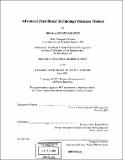| dc.contributor.advisor | Erik Brynjolfsson. | en_US |
| dc.contributor.author | Ghosemajumder, Shuman, 1974- | en_US |
| dc.contributor.other | Sloan School of Management. | en_US |
| dc.date.accessioned | 2005-08-23T20:11:16Z | |
| dc.date.available | 2005-08-23T20:11:16Z | |
| dc.date.copyright | 2002 | en_US |
| dc.date.issued | 2002 | en_US |
| dc.identifier.uri | http://hdl.handle.net/1721.1/8438 | |
| dc.description | Thesis (M.B.A.)--Massachusetts Institute of Technology, Sloan School of Management, 2002. | en_US |
| dc.description | Includes bibliographical references (leaf 58). | en_US |
| dc.description.abstract | The mass adoption of the Internet and the creation of digital standards for the storage of information goods ( e.g. written documents, audio recordings, videos) has allowed individuals to exchange these goods with one another on an international scale with essentially no marginal cost. This phenomenon has been accelerated by the rise of peer-to-peer (P2P) file sharing systems. which provide a public marketplace for the express purpose of finding and exchanging these goods. Napster was the first such system, and is still the most famous, but its demise has been followed by the ascendance of more powerful systems such as KaZaA, Gnutella. and Freenet - which now boast more aggregate users than Napster ever had. This thesis examines the social behaviors, economic ramifications, legal issues, and technological developments which are the results of this ultimate form of disintermediation. It concludes by proposing a strategy for the effective commercial distribution of information goods in a world of free exchanges. The recording industry is examined most closely, since this is the industry with the most copyrighted content available on these systems. Primary data has been collected from 23 interviews with industry representatives, technologists and end users plus 206 questionnaires from end users alone. An additional 1141 questionnaires were administered anonymously via the Internet for comparison. The results indicate that a viable business model requires several responses to current trends. The qualitative model proposed in this thesis consists of three strategic complementarities: I . A new pricing model. 2. A commercial file sharing standard. 3. A strategy for minimizing the negative impact of free exchanges. The suggested format for each of these actions is examined. It is argued that all three responses are crucial for the online success of any information goods industry, and that an incomplete solution will be rejected by consumers. | en_US |
| dc.description.statementofresponsibility | by Shuman Ghosemajumder. | en_US |
| dc.format.extent | 58 leaves | en_US |
| dc.format.extent | 6345448 bytes | |
| dc.format.extent | 6345207 bytes | |
| dc.format.mimetype | application/pdf | |
| dc.format.mimetype | application/pdf | |
| dc.language.iso | eng | en_US |
| dc.publisher | Massachusetts Institute of Technology | en_US |
| dc.rights | M.I.T. theses are protected by copyright. They may be viewed from this source for any purpose, but reproduction or distribution in any format is prohibited without written permission. See provided URL for inquiries about permission. | en_US |
| dc.rights.uri | http://dspace.mit.edu/handle/1721.1/7582 | |
| dc.subject | Sloan School of Management. | en_US |
| dc.title | Advanced peer-based technology business models | en_US |
| dc.type | Thesis | en_US |
| dc.description.degree | M.B.A. | en_US |
| dc.contributor.department | Sloan School of Management | |
| dc.identifier.oclc | 50655972 | en_US |
